|
|
|
|
ALGEBRA
|
|
|
|
::
Vectors
and a coordinate system, Cartesian
vectors
|
|
Vectors in
a coordinate plane (a two-dimensional system of coordinates), Cartesian
vectors
|
|
By introducing a coordinate system in a plane with the unit vectors,
i and
j
(in direction of x
and y
coordinate axis, respectively) whose tails are in the origin O, then each point of the plane determines a vector
r
= OP. |
| A directed line segment from the origin to a point
P (x,
y) in plane is called a
radius vector and denoted
r. |
| The radius
(or position) vector equals the sum of its
vector components,
xi
and y j
in direction of coordinate axes, that is |
 |
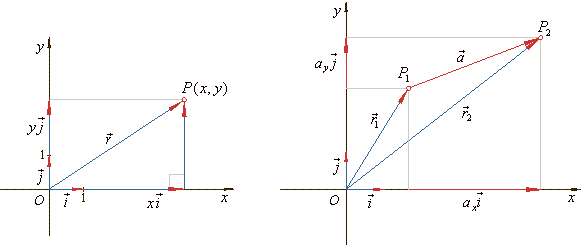 |
| Consider
a vector a
in the plane directed from a point
P1(x1,
y1)
to P2(x2,
y2)
shown in the right diagram, it also equals to the sum of corresponding
vector components
axi
and
ayj,
in direction of coordinate axes,
|
 |
| The diagram shows that |
 |
are the radius vectors of
points P1 and
P2, |
|
| thus
the vector a
equals to the difference (joins their heads), that is |
 |
It is obvious from the above diagrams that a vector and its components, i.e., its projections in direction of
coordinate axes, form a right triangle, from which, according to Pythagoras’ theorem, we determine the length of the vector, |
 |
|
|
Example: Determine a vector a whose tail is at the point
P1(-4,
1) and head at the point
P2(-1,
-3).
|
|
Solution: Points, P1 and
P2 determine radius vectors, |
 |
| therefore, |
 |
|
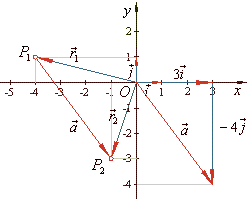 |
|
|
Vectors in
three-dimensional space in terms of Cartesian coordinates
|
|
By introducing three mutually perpendicular unit
vectors, i,
j and
k, in direction of coordinate axes of the
three-dimensional coordinate system, called
standard basis vectors, every point
P(x,
y, z) of the space
determines the radius vector or the position vector,
|
|
|
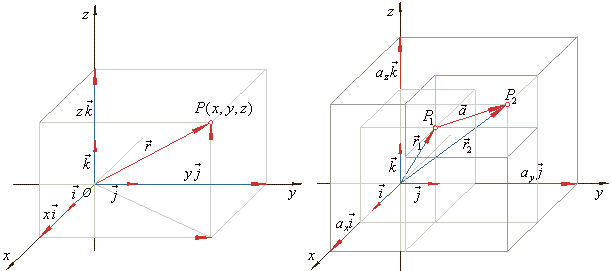 |
|
Similarly, a vector a
in the right diagram, which is directed from a point P1(x1,
y1, z1)
to a point
P2(x2,
y2, z2)
in space, equals to sum of its vector components, axi,
ay j,
and
azk,
in the direction of the coordinate axes,
x,
y, and
z
respectively, that is
|
 |
|
The vector
a
is the difference of the radius vectors, |
 |
|
| thus |
 |
|
 |
| so the scalar (numeric) components of the vector
a,
|
 |
| Therefore, the length of the vector
a,
|
 |
|
|
Angles of vectors in relation
to coordinate axes, directional cosines - scalar components of a vector
|
|
The scalar components of a vector and its magnitude form a right triangle in which the hypotenuse equals the magnitude of the vector, then
|
 |
|
since b
= 90° -
a
then cosb
= sina, |
| and
components of a vector a, |
 |
|
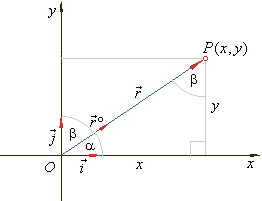 |
|
|
|
If a vector
a
in 3D space forms with the coordinate axes, x,
y and z
angles,
a,
b
and g
respectively, then
|
|
components of the vector are,
|
 |
| while for the radius vector of the point
P(x,
y, z),
|
 |
| Thus, for angles, a,
b
and g
hold the expressions,
|
 |
| called the
directional cosines of the vector
a.
|
|
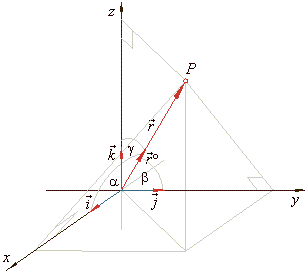 |
|
|
|
The unit vector of the vector
a,
|
 |
 |
| This condition must satisfy angles that a vector in three-dimensional space form with the coordinate axes.
|
|
For vectors in a coordinate plane
|
 |
and since
b
= 90° -
a,
then |
|
| cosb
= cos(90°
-
a)
= sina,
follows |
 |
the basic trigonometric identity.
|
|
|
|
Similarly, the
unit vector of a radius vector
in
space
|
 |
| determined by corresponding directional
cosines.
|
| Therefore the radius vector forms with coordinate axes
angles,
|
 |
| As vectors are uniquely determined by its components or coordinates, they are usually denoted using
matrix algebra notation, in the coordinate plane, |
 |
| and in the 3-D
space |
 |
|
|
|
Vectors in
a three-dimensional coordinate system, examples |
| Example:
Determine angles that a radius vector of the point
A(3,
-2, 5) forms with the coordinate axes. |
|
|
|
Example:
A vector
a
in a 3D-space, of the length | a
|
= 4, forms with axes,
x and
y
the same angles, a
= b
= 60°, find the
components (coordinates) of the vector a. |
|
Solution: Using relation |
 |
| applying given conditions, |
 |
| The components of
a, |
 |
|
|
Example: Prove
that vectors, a
= -i
+ 3 j
+ k,
b
= 3i -
4 j -
2k and
c
= 5i -
10 j -
4k
are coplanar. |
|
Solution: If all three vectors lie on the same plane then there are coefficients,
l and
m such that, for example
c
= la
+ mb,
i.e., each of the vectors can be expressed as the linear combination of the remaining two. |
 |
 |
|
|
|
|
|
|
|
|
|
|
|
|
|
|
|
|
|
|
|
|
|
|
|
|
|
|
|
|
Contents
B
|
|
|
|
|

|
|
|
|
|
|
Copyright
© 2004 - 2020, Nabla Ltd. All rights reserved.
|
|
|